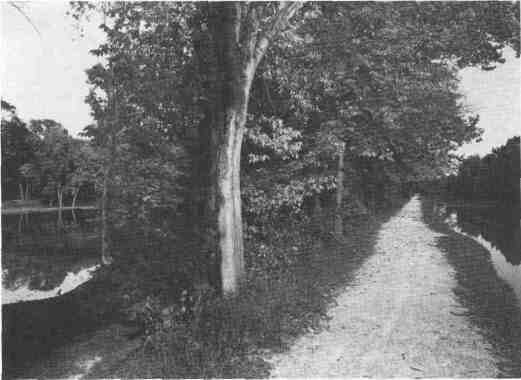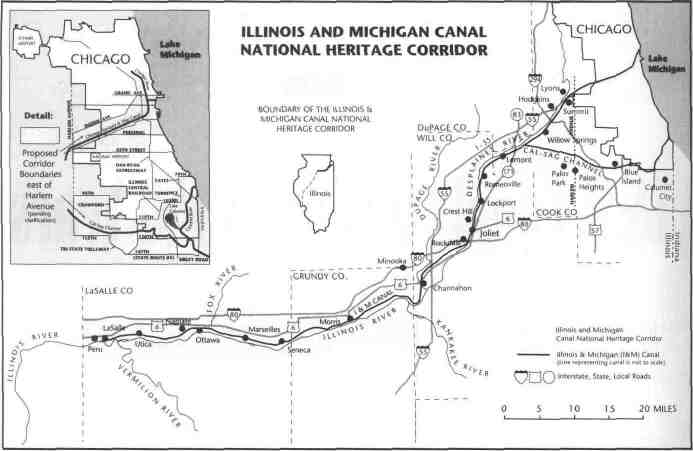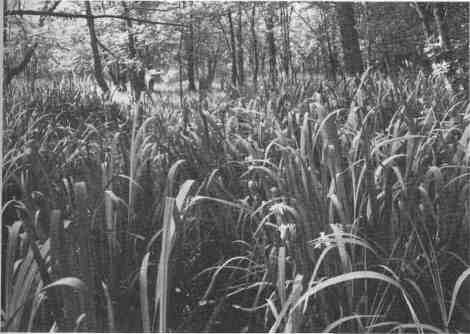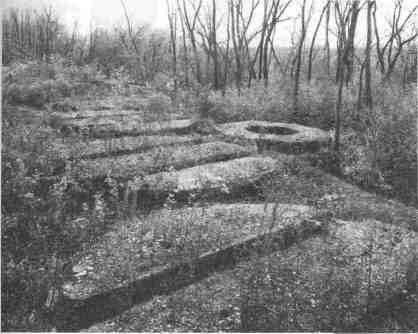
I & M, Oh, I & M! Yes, I am asingin' 'bout the mighty I & M. Linked the ocean to the Lakes, the last link in a chain - Easy travelin', sure and sweet, is why the people came.
Travel, trade, and settlement is what the ole ditch brought. Buildin' buyin' sellin' is what the settlers' sought. Plowin' up the prairie sod and plantin' wheat and corn, Gave the towns both big and small the reason they were born.
- from the song 'I&M Canal Epic' in 19 verses, words by Char Giardina of the III. Dept. of Natural Resources, I&M Canal State Trail and music by Christine Gayford of Gallimaufry, 1997
Photo: The Illinois & Michigan
(I&M) Canal State Trail, Gebhard
Woods, Morris, Ill. Photograph by
Edward Ranney.

March/April 1998 ¦ 31
SPECIAL FOCUS

Celebrate the Sesquicentennial of the I & M Canal: 1848 - 1998
After 12 years of laborious construction and many more years of
planning and surveying, the Illinois and Michigan (I & M) Canal
opened to commercial traffic in 1848, creating a link by water
between the eastern seaboard and the Mississippi River. The Canal
enabled a continuous flow of people and goods into the Midwest,
and firmly established Chicago as the Midwest's commercial
hub, the largest inland port and the gateway to the frontier.
In 1984, Congress recognized the significance of the I & M
Canal and the history of the ancient transportation corridor it
follows, by designating it the nation's first National Heritage
Corridor.
This year, the I & M celebrates its sesquicentennial. Many events
are planned by the Canal Corridor Association to celebrate I & M's
150th year, including:
• a 200-page book entitled Prairie Passage: The Illinois & Michigan
Canal Corridor, featuring the work of internationally
acclaimed photographer Edward Ranney and text by Tony Hiss
as well as supporting essays by William Least Heat-Moon,
Emily Harris and Edward Ranney, to be published by the
University of Illinois Press in April.
• "Prairie Passage," an exhibit featuring the black-and-white
photography of Edward Ranney, taken between 1992 and
1996 of urban canyons and waterways, plus historic 19th-
and 20th-century photographs of workers hand-digging the
canal, scenes from canal towns. The exhibit opens at the
Chicago Cultural Center (April 18 - June 28), then travels
to the Illinois State Museum in Lockport (July 24 - October
30) and Springfield (Jan. 17 - March 7, 1999).
• The 49 towns along the Corridor will host a variety of
commemorative events during the Sesquicentennial, including
festivals, parades, tours, hikes, lectures and more.
• First U.S. Open Match Fishing Championship, May 30-31
in LaSalle.
For more information about the exhibit, contact the Canal Corridor Association, 312.427.3688, ext. 388. For general information, call the Heritage Corridor Visitors Bureau 815.727.2323.
32 ¦ Illinois Parks and Recreation
I & M CANAL CELEBRATES 150 YEARS


|
Photographs: Varying images of the Illinois & Michigan Canal; (top) Yellow flag Iris, Centennial Trail, Romeoville, III.; (bottom) foundations of hot blast stoves, former U.S. steel works, Joliet, III. Photographs by Edward Ranney from ''Prairie Passage," an exhibit celebrating the 150th anniversary of the I & M Canal, sponsored by the Canal Corridor Association and the Illinois State Museum. Permission to reprint the photographs was granted by the Canal Corridor Association. "Take a first look: there are places where the I & M is nearly invisible, its banks either overgrown by an impenetrable tangle of brambles or overshadowed by looming storage tanks and sheds at the edge of large-scale modern industrial sites. Stretches of the I & M are so dry you couldn't even get a canoe through, and miles of the canal are missing altogether—filled decades ago to make room for an elevated expressway.
Now take a second look, at the tremendously skillful symmetrical simplicity of the stonework that lines the high, tight walls of the canal locks; at the way in which 19th-century engineers contrived the canals course so that the I & M slips through the landscape with such tact, modesty, and neighborliness that communities are never compromised by its presence but only made more comfortable; at the canal's many confluences, the places where it cuts across or flows into another waterway, stream, river or canal, and in so doing seems to come together with and lend its shape and dignity to a larger landscape." |
- by Tony Hiss, author of Prairie Passage: The Illinois & Michigan Canal Corridor, published by the University of Illinois Press (April, 1998)
March/April 1998 ¦ 33